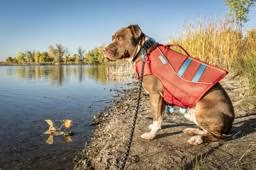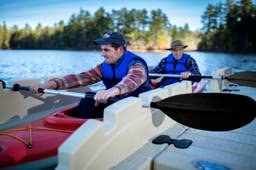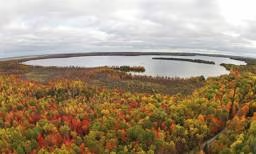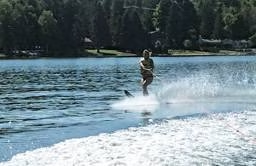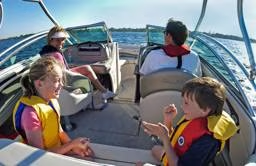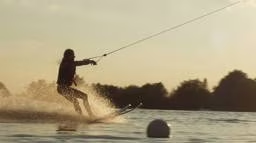Most waterskiers don’t ski across chilly autumn or winter water to impress their fellow lakeside cabin owners. Waterskiers who ignore the calendar, zip up their wet suits – and even dry suits – and brave the cold water simply long to ski, love to ski and maybe even live to ski.
There’s the Martin family in Maine who ski in the fall until feet and hands are too numb to go on, Gary in Washington who has walked across a snowy dock to board his ski boat and Daryl and Frannie in Missouri who have broken through lake ice to get their ski boat out on the water. Then there’s Ron in Florida who skis despite the winter chill and, well, even alligators.
For skiers in such disparate locales, “cold” is a relative term, and they all define it differently. But they all define fun with the same, singular word: waterskiing.
The Martin family is the first out on the lake in May when the water temperature is still below 60, and the last ones off in the fall. The very last ones – after all the other skiers, boats and even docks are off the lake.
Every year, Chuck and Teri Martin move from New Hampshire to their lakehouse on Maine’s Lake Wilson for the months of July and August with their teenage sons Ryan and Chase. During these two months, when the water temp has climbed into the 70s, the foursome logs 120 hours on the water. That’s a lot of skiing and means the family is in the boat practically every day.
When there’s no dock, the Martins trailer their ski boat to the lake, using the lake’s public boat landing to launch the boat. The beauty of fall (and spring) skiing, the Martins say, is there are no other boat wakes with which to contend, and the lake seems bigger with no docks. “It’s just us, our skis and the loons – and we stay away from the loons.”
But the water gets cold, even with wet suits. “The water spraying on your face feels like ice water. And our hands and feet get so numb we need help getting into the boat,” Chuck says, adding “But we love it. It’s a great family sport. The kids would ski right up until the ice comes in if we let them.”
Skiing is more bearable for the Martins because their boat comes equipped with heaters. There’s one under the driver’s seat and another under the nearby passenger’s seat that can be pulled out, like a large hose, and placed where needed – on feet or maybe in a makeshift towel tent. The Martins also use their boat’s bimini top to help keep heat in. And Teri keeps towels at the ready for skiers coming out of the lake. But, Chuck says, “Mainly, we just shiver.”
It’s all worth it, though, he says. “When winter comes in New England, the skiing is done, and winter is long here. We make summer as long as it can be – even if it’s fall.”
See also VIDEO: Waterskiing in October
Happy New Year!
Garry Wood loves to ski. In his view, he didn’t get enough time on top of the water as a kid. So now he’s making up for lost time, even if it means walking barefoot over a snowy dock to reach the lake.
The primary residence of Garry and his wife Cheryl is in Bellingham, Washington. The Woods mostly ski on nearby Lake Samish where they own a summer cottage, but also ski frequently on a local private lake and will occasionally travel to Arizona’s Lake Havasu for skiing.
But don’t let the Arizona travel fool you; the Woods are not averse to cold. They ski 11 months out of the year on Lake Samish. In fact, together with two neighboring couples and other varied joiners-in, they put a whole new spin on the New Year’s celebration. They go waterskiing.
Why? “As long as we get that New Year’s ski in, we feel like we’ve gotten a full season in,” Garry Wood explains. The Woods and their skiing friends winterize their boats after the New Year’s outing and skip skiing in February – since January and February are the two coldest months – but pride themselves on their 11 months of skiing.
The New Year’s Day ski is a 10-year-old tradition, although Wood admits they did forego skiing one year when a terrible storm made the lake too dangerous and choppy for skiing.
“One of the first years,” Wood recalls, “there were snow flakes coming down as we skied. We had snow on the dock, and it was really cold walking over about 11/2 inches of snow with bare feet to get to the boat.” Auld lang syne, indeed.
More typically, the challenging elements are rain and cold air. With the Pacific Northwest’s penchant for winter rain, it’s not uncommon to see 30 straight days of rain, Wood says. Then there’s the brisk winter air, which can be a problem for the boat driver.
At 34 mph, the boat creates quite a wind chill, Wood explains, and the boat driver’s head is exposed because it comes up over the top of the windshield. “We’ve had to switch drivers because the driver gets so cold his face turns red like a tomato.” Meanwhile, chilled passengers will compete for time in front of the heater.
Behind the boat, Garry and his fellow skiers contend with water that’s 40-something degrees Fahrenheit by wearing dry suits with sweatpants underneath.
And, on they ski. “We always make sure we ski once or twice a month in December, January and March – so we can say we skied that month,” Wood says. “Maybe this year we’ll try to ski all 12 months.”
To Waterski or Ice Skate?
Down in Missouri, Daryl Granzella and friends on Lake Winnebago take it a step further. They usually ski 12 months a year, even if it means breaking through the ice to get the boat out on the lake.
Last winter on Lake Winnebago the skiing was on again, off again, and just plain weird. December: Granzella says he and his ski buddies broke through the ice near shore to get the boat out into free water. New Year’s Day:?A slightly warmer, ice-free lake allowed the waterski friends to uphold their tradition of skiing on the first day of the year. Later January: The whole lake froze over so that local residents brought out their ice skates. February: Another reprieve in the form of a February thaw allowed the waterskiers to reclaim their lake.
Skiing 12 months a year obviously requires that the ski boat is always at the ready. Granzella keeps his boat on his boatlift most of the year, keeping most ice away from the lift and dock with the aid of an aeration pump. But, he says, “the boat comes out when it seems the lake will freeze over. Haven’t guessed wrong so far.”
And how exactly, did they break through the thin ice last December? “Someone is in the bow breaking the thin ice with a broom handle while we slowly idle to open water.” Somehow, we’re guessing this technique is not listed in any trouble-shooting guides published by ski boat manufacturers.
Besides the broom, other winter ski provisions include dry suits when the water temperature dips below 60 degrees Fahrenheit, gloves, hoods and thin booties. After skiing, there’s the hot tub at the Granzella household for warming up – especially feet and hands.
Daryl and his wife Frannie have lived on Lake Winnebago since 1999 and have skied 12 months a year most years. Enthusiasm for skiing is high. Only a handful of people ski New Year’s Day, but that number may increase now that 35 local skiers recently formed the Winnebago Water Wizards ski club.
Granzella is proof that skiing is for the young and young at heart. With Frannie temporarily out of commission with a sore back, Granzella’s main ski partners currently are two 13-year-olds from the ski club. “They’re good drivers and great skiers. They call me ‘Uncle Daryl’” reports Granzella, a 56-year-old who’s been skiing since he was 8 or 9.
Braving the Elements and the Gators
Well south of Missouri, Ron Snyder skis in front of his lakehome on Florida’s Lake Florence. And since it’s Florida, the skiing never stops. Of course, winters in the Sunshine State aren’t so severe, but there are other obstacles – like alligators.
Snyder, who’s 48 and started skiing in his teens, skis almost exclusively on Lake Florence, saying “It’s a convenience thing.” He and his next-door skiing buddy have set up a slalom course in front of their docks, and they’re usually out on the lake before sunrise.
Sure, when it gets colder in the winter – which Snyder defines as air temperatures below 60 – he will forego skiing early in the morning and on stormy, windy days.
But otherwise, Snyder’s out there. To combat the winter chill, he has a full arsenal of wet suits to draw from. “I have all different configurations: short sleeves, short legs, full suit, 3.2 millimeter, 4.3 millimeter and a vest too.” No dry suits, but this is Florida after all.
Snyder’s ski boat has heaters, but they get little use. “The temperatures are not that bad here. We mainly use the heater to defog the windshield in the winter.”
Snyder is a Florida skier through and through. “I’ve skied in Atlanta in the winter, but that’s too far north for me.”
As for the alligators? “We don’t worry about alligators. There’s one that hangs out by my dock that’s about 5 feet. We usually get them taken out of the lake.”
Tips from the Pros for Cold Weather Waterskiing
• Ski gloves are a must for the skier. For super cold skiing, try latex dry suit gloves.
• Wet suits are sometimes not enough; for super cold skiing, check out dry suits.
• For ultimate warmth, full fleece “bunny suits” can be worn under the dry suit.
• Booties of neoprene or latex help keep feet warm.
• Neoprene hoods or headbands are available to keep your head and ears warm while skiing.
• Bring lots of big, body-sized towels.
• Bring a cooler filled with hot water in the boat for skiers to immerse their hands and feet in after a run.
• Check out aftermarket boat heaters and accessories – especially the hot showers.
• Bring very warm, loose-fitting, comfortable clothes to change into after skiing.
• Don’t forget the drivers and riders. Keep their hands and heads warm with driving/winter gloves and bomber-style, fleece-lined hats.
• A thermos of hot cocoa works wonders!


